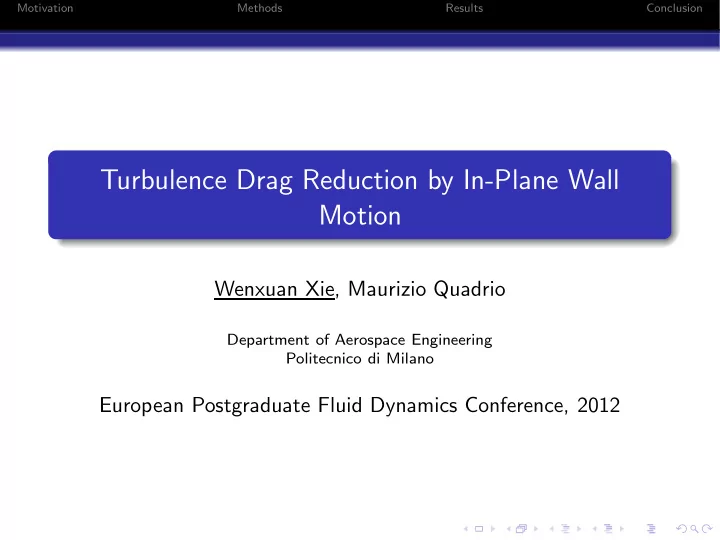

Motivation Methods Results Conclusion Turbulence Drag Reduction by In-Plane Wall Motion Wenxuan Xie, Maurizio Quadrio Department of Aerospace Engineering Politecnico di Milano European Postgraduate Fluid Dynamics Conference, 2012
Motivation Methods Results Conclusion Why turbulence drag reduction? Turbulence drag plays an important role in: Air transportation Ground transportation Water transportation Pipeline oil transportation ...
Motivation Methods Results Conclusion Why turbulence drag reduction? (cont.) The breakdown of the drag on an aircraft (Schrauf, Community Aeronautics Days 2006)
Motivation Methods Results Conclusion Flow control techniques Passive control no actuators, e.g.riblets (simple, less e ffi cient) Active control open-loop with actuators but no sensors (relatively simple, e ffi cient) closed-loop with both actuators and sensors (complex, e ffi cient)
Motivation Methods Results Conclusion Flow control techniques (cont.) Turbulent drag reduction by in-plane wall motion: Spanwise-oscillating wall (Quadrio et al 2004 JFM) 1 relatively large drag reduction, low net energy saving Streamwise travelling waves (Quadrio et al 2009 JFM) 2 large drag reduction, higher net energy saving Spanwise travelling waves 3 wall motion body forcing
Motivation Methods Results Conclusion Spanwise travelling waves (of spanwise velocity)
Motivation Methods Results Conclusion Spanwise travelling waves body forcing: F z = Ie − y / ∆ sin( κ z z − ω t ) Drag reduction 30% based on very limited observations, net savings unknown. (Du et al JFM 2002) wall motion: w = A sin( κ z z − ω t ) Two methods give similar results in turbulence statistics and drag reduction. (Zhao et al Fluid Dyn Res 2004) If κ z = 0, wall oscillation
Motivation Methods Results Conclusion Method Aim find the optimal point in the 3d parametric space ( A − ω − κ z ) with the best energetic performance. Around 250 Direct Numerical Simulation for the turbulent channel flow L x = 4 . 8 , L y = 2 , L z = 3 . 2 non-dimensionalized by h (half of the channel height) nx = 64 , ny = 100 , nz = 128 ∆ + x = 10 , ∆ + z = 5 Re τ = 200 (corresponding to Re = 4760)
Motivation Methods Results Conclusion Map of Drag Reduction and Net Energy Saving A=0.1 R S 10 10 10 10 5 5 0 0 8 -5 8 -5 -10 -10 κ z κ z -15 -15 -20 6 6 -20 -25 -25 -30 -30 -35 4 4 -35 -40 -40 -45 -45 -50 2 2 -50 -55 -55 -60 -60 0 0 0 2 4 0 2 4 ω ω
Motivation Methods Results Conclusion Map of Drag Reduction and Net Energy Saving (cont.) A=0.2 R S 25 15 10 20 10 10 15 5 10 0 5 -5 8 8 0 -10 κ z -5 κ z -15 -10 -20 6 6 -15 -25 -20 -30 -25 -35 4 4 -30 -40 -35 -45 -40 -50 2 2 -45 -55 -50 -60 -55 0 0 -60 0 2 4 0 2 4 ω ω
Motivation Methods Results Conclusion Map of Drag Recution and Net Energy Saving(cont.) A=0.5 R 40 35 S 30 10 10 0 25 -5 20 -10 15 -15 8 8 10 -20 5 κ z κ z -25 0 -30 6 6 -5 -35 -10 -40 -15 -45 4 4 -20 -50 -25 -55 -30 -60 2 -35 2 -40 -45 -50 0 0 0 2 4 0 2 4 ω -55 ω -60
Motivation Methods Results Conclusion Modification of Near Wall Turbulence
Motivation Methods Results Conclusion Spanwise flow rate ∇ z P = 0 in all simulations spanwise flow rate arises for most of the simulations analogy to travelling wave of blowing and suction 10 FLOWZ 0.1 0.05 0 8 -0.05 -0.1 -0.15 κ z -0.2 6 -0.25 -0.3 -0.35 -0.4 4 2 0 0 2 4 ω
Motivation Methods Results Conclusion ”Streaming” e ff ect from blowing/suction waves Suppose the blowing/suction wave is travelling from left to right. We look at a particle originally at distance y 0 from the wall: In the first cell (the cell on the right), the particle is first pushed towards the wall and then blowed back to y 0 , the particle is travelling in region y < y 0 In the second cell, the particle is first blowed towards the center line and then sucked back to y 0 , the particle is travelling in region y > y 0 Hoep ff ner and Fukagata JFM 2009
Motivation Methods Results Conclusion In the case of standing wave Di ff erent initial fields lead to di ff erent sign of the flow rate. The symmetry is kept on time average. The absolute values of the flow rate qualitatively agree with the drag reduction values from standing wave of blowing and suction. (Mamori and Fukagata ETC 2011) 0.2 0.15 0.1 0.05 flow rate 0 -0.05 -0.1 -0.15 -0.2 0 200 400 600 800 1000 t
Motivation Methods Results Conclusion Conclusion From the global map: relatively large maximum drag reduction, but low net energy saving outperformed by the spanwise wall oscillation From the flow statistics: near wall turbulence cycle is modified creation of spanwise flow rate (could be used?)
Motivation Methods Results Conclusion Thank you all!
Recommend
More recommend